Trust Wallet Review: Is It the Right Choice for You?

Trust Wallet is a non-custodial mobile cryptocurrency wallet owned by Binance. It lets users control their digital assets, including cryptocurrencies and NFTs. With support for 100 blockchains and access to 10 million crypto assets, Trust Wallet allows secure storage, sending, and receiving of millions of tokens. It offers a user-friendly interface, multi-chain support, and Web3 access. Trust Wallet is trusted by over 60 million users worldwide and is also available as a browser extension. It enables users to buy, store, exchange, and earn crypto, track charts and prices, and use decentralized apps within the wallet for enhanced security.
We bang this drum a fair bit here at the Coin Bureau, but in case you haven’t heard, here’s how the tune goes: if you’re serious about keeping your crypto safe, you should be thinking about storing it in a wallet of some kind. The larger your holdings are, the more pressing a concern this should be.
Yes, exchanges have beefed up their security protocols in the wake of past hacks and branches, and the best ones now insure their client funds as a matter of course. But despite these precautions, there is no substitute for using a reputable wallet and holding those all-important private keys yourself. While we’re a big proponent of hardware wallets, for those with relatively smaller holdings, you could consider storing your crypto in software wallets as well.
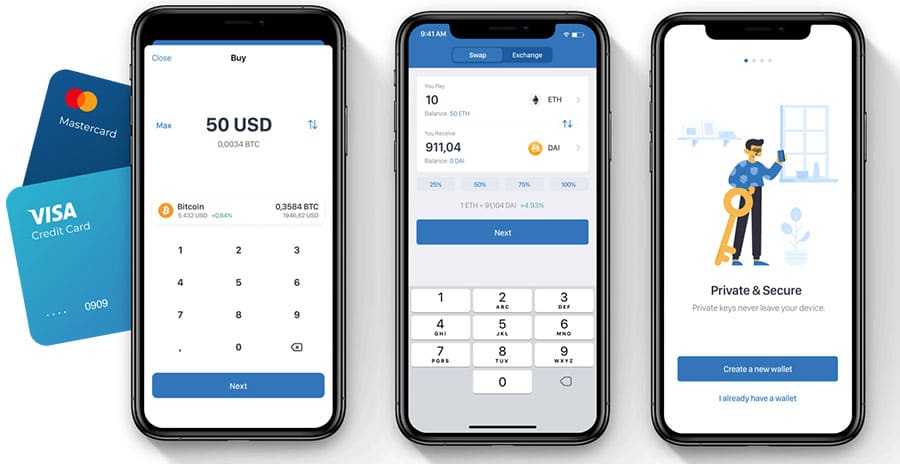
Software wallets are installed as apps on your phone and so benefit from being with you all the time. You’re unlikely to find yourself out and about and unable to trade. While not quite as secure as hardware devices, the best of these are still a better option for storing your crypto than on a centralised exchange.
Today, we are conducting a Trust Wallet review, one of the most recognisable and popular software wallet options. We’ll run over the specs, take a look at what it can do, weigh up its pros and cons, and perform a Trust Wallet analysis. You should, by the end, have a good idea of whether or not this mobile wallet is an option for you.
What Is Trust Wallet?
Trust Wallet is a decentralised, mobile cryptocurrency wallet that supports over 53 blockchains and 1 million+ digital assets. It allows users to stake their coins to earn interest. It also offers a built-in Web3 browser that gives users access to decentralised applications (DApps) built on various blockchains. Currently, the Trust Wallet DApp browser connects to around 16 networks.
It was originally designed to hold ERC20 and ERC223 tokens but now also holds those built on other blockchains, including – of course – Bitcoin. In addition, coins can be bought through the native decentralised exchange (DEX) that runs through Trust Wallet’s collaboration with the Kyber Network.

The Trust Wallet app is available as a free download for iOS and Android. Much of its functionality can be attributed to the fact that its code was written in the native languages of each platform: iOS’ Swift and Android’s Java. The app runs on iOS 10.0 versions or higher and Android 5.0 and up.
The user interface is clean and straightforward, making it easy to download, set up, and get started. This has seen Trust Wallet accrue 25 million+ users to date, helped largely by its partnership with Binance, announced back in July 2018.
This partnership with the biggest name in the crypto space – and its deep pockets – is sure to keep users flocking to Trust Wallet and will almost certainly fuel the development of further features on the app.
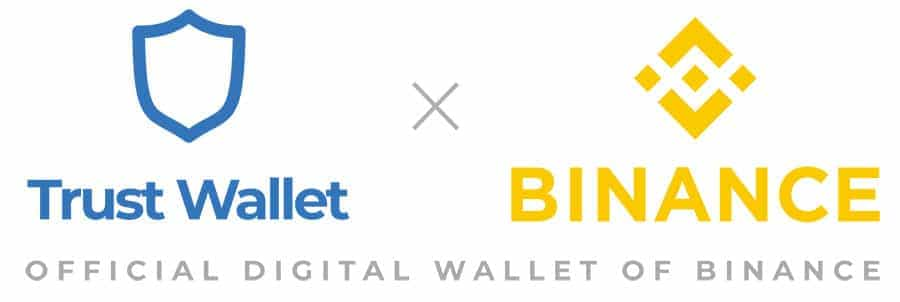
The app allows users to add extra security using a pin code or fingerprint scanning. These can be activated through the setting function in the app. Unfortunately, there is not yet an option for two-factor authentication.
Finally, there’s the question of backup, which Trust Wallet has addressed through the use of a 12-word recovery phrase. Users are given one of these phrases to write down and store securely when setting up their wallet address.
If anything goes wrong, this can be retrieved and entered to recover access to the account. Of course, it goes without saying that this should be written down and stored with the utmost care as a priority when going through the setup process.
Trust Wallet History
Trust Wallet is the brainchild of Viktor Radchenko, a US-based Ukrainian software developer who first heard about cryptocurrencies in much the same way as many of us did: through the use of Bitcoin on the dark web.
However, it was through Ethereum that his interest in crypto began to gather pace. He cut his teeth developing an app to help truckers find parking and other amenities while at the same time diving ever deeper into the crypto waters.
Viktor began developing Trust Wallet to hold the growing number of ERC20 tokens that he was acquiring through ICOs. Work began on the project in 2017, and it quickly became the focus of all his efforts.
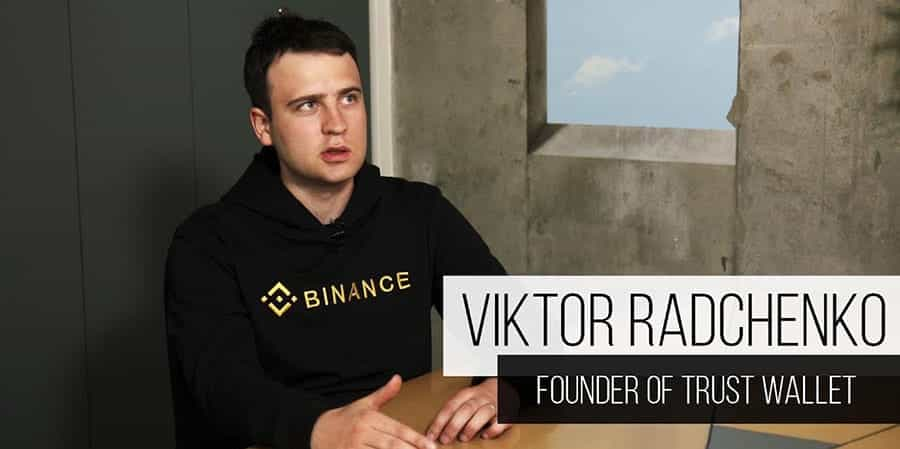
The functionality with ERC20 standard tokens attracted thousands of early users in a short space of time. The wallet’s growing popularity then caught the attention of Binance, who acquired the project (and its parent company Six Days LLC) for an undisclosed sum back in 2018.
As with any self-respecting crypto project, much of the focus is on mass adoption through ease of use. Viktor himself has stated that ‘letting people buy cryptocurrency with a credit card or bank account is essential for crypto adoption’, and Trust Wallet has held true to his vision in this regard. As a result, the app has put plenty of work into making its user interface easy to use and accessible to all.
In 2023, Trust Wallet went through a major rebrand, giving the product a new look and revamping the user interface. The transformation was intended to not only enhance user experience but also plant a stake in the ground and make a statement that this wallet is primed and ready for the global expansion to Web3.
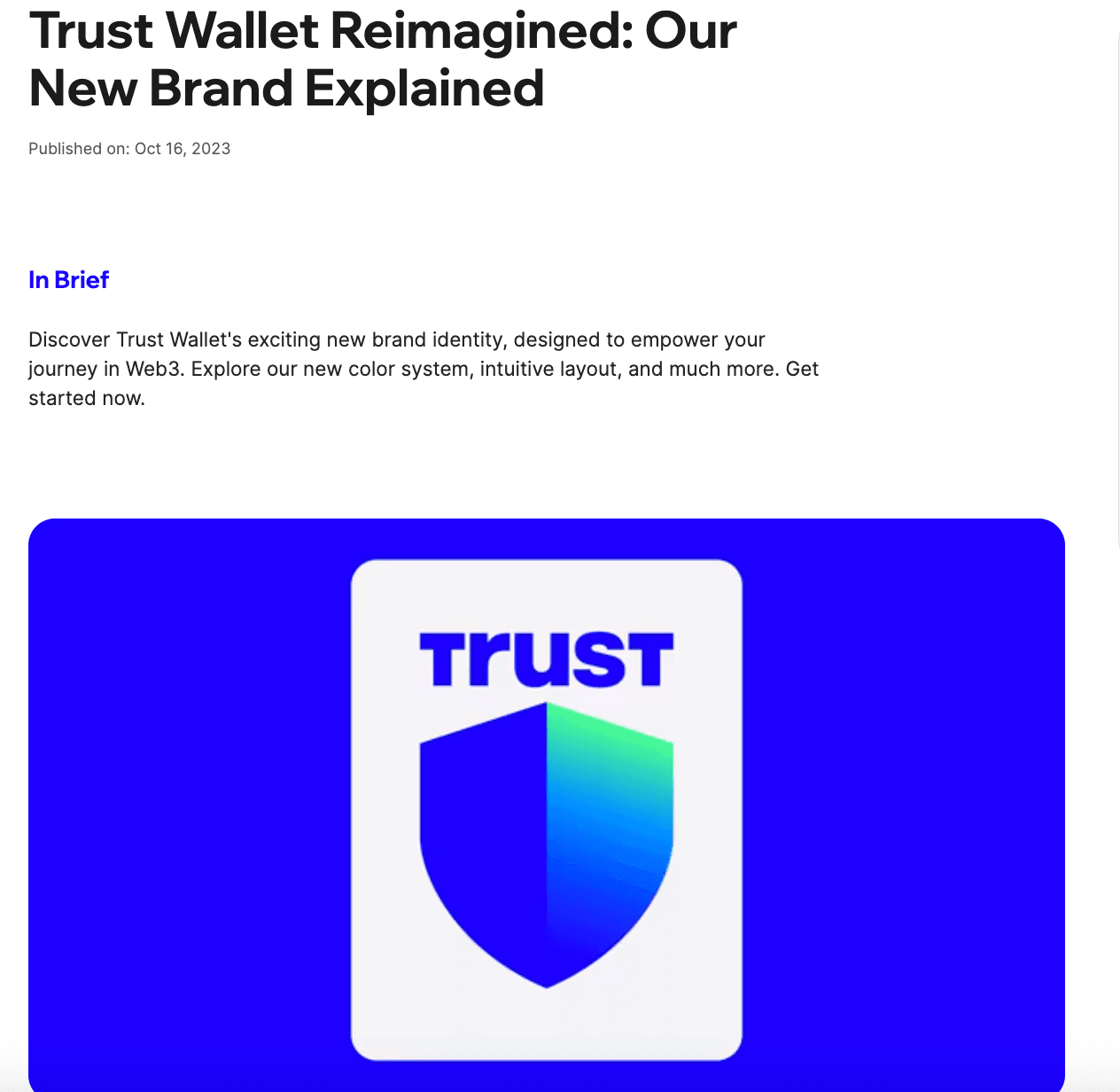
Here's a breakdown of what is new:
- Intuitive Layout & Simplified Design
- Trust Wallet Shield- Provides users with peace of mind as they explore Web3. The shield helps protect users against clicking on malicious links or interacting with exploitable smart contracts.
- The “Trust” in Trust Wallet logo is bold, representing trust itself, the wallet's colours have been revamped for looks and to support light and dark modes, and illustrations were added to make it more aesthetically pleasing.
Getting Started with Trust Wallet
The Trust Wallet app is available from either Google Play or the App Store. Once downloaded and installed, you’ll be given the option to either import an existing wallet or create a new one. If you select the latter option, you’ll be given your 12-word seed or recovery phrase.
As mentioned already, make sure you note this down carefully and store it somewhere safe. You’ll then see a checkbox saying: “I understand that if I lose my recovery words, I will not be able to access my wallet.”
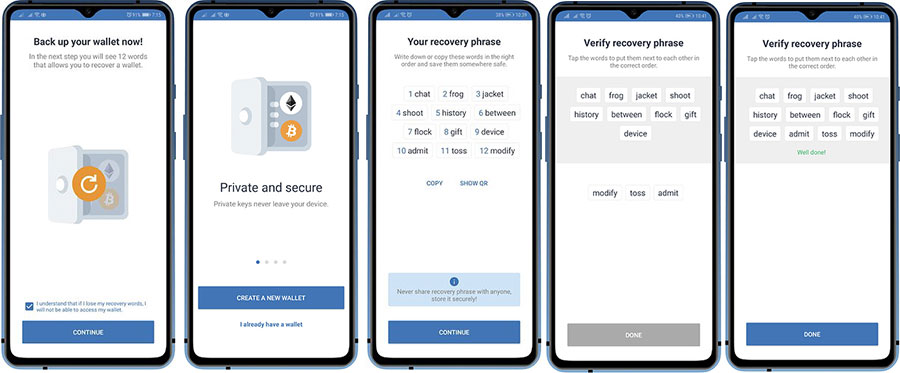
If you want to add crypto to your wallet, simply log in and tap the “Receive” button. A QR code will appear for you to scan, or you can copy your wallet address. Then, paste the address into the other wallet’s receiver address section. The “Transactions” tab will show you which ones have been completed.
Sending crypto is just as straightforward. Once in your wallet, tap the “Send” button, then copy and paste the address of the receiving wallet. That done, type in the amount to be sent and tap the “Next” button. Once you’re happy that all the details are correct, hit “Send”, and you’re good to go.
A big part of Trust Wallet’s appeal is its ease of use and intuitive interface. A lot of effort has gone into this aspect of the app, and user reviews regularly focus positively on it.
Trust Wallet Staking
The staking of crypto (derived from the term “Proof of Stake”) involves the creation of new blocks via a consensus algorithm. These new blocks are then added to the blockchain.
New transactions can be validated on the blockchain by coins staked by holders. The number of staked coins determines the number of transactions that can be validated. Staking locks the coins into a wallet for a prescribed time, with more coins (a bit like interest accruing) added to the wallet as a reward. As with interest, the more you stake, the more you get back.
So, if you want to earn interest from your crypto holdings, or are keen to have a say in how the networks of particular currencies are governed, then the staking function that Trust Wallet allows is something you should explore.
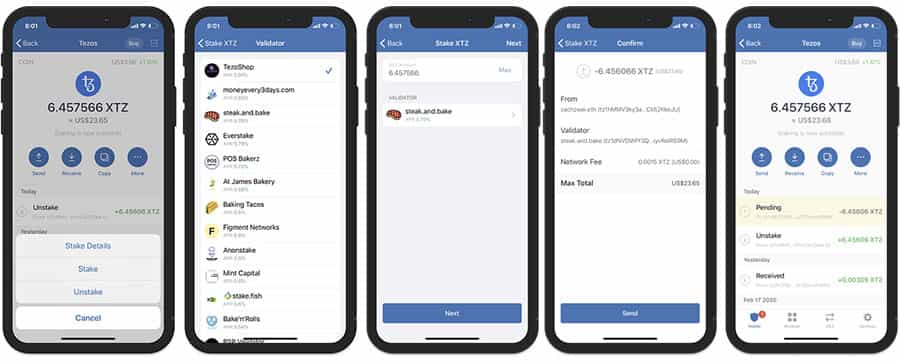
Not all coins support staking, though the list is growing. At some point in the future, both Ethereum (ETH) and Cardano (ADA) will become available for staking, having switched to using Proof-of-Stake (as opposed to Proof-of-Work) systems.
At present, Trust Wallet allows you to stake: Tron (TRX), Tezos (XTZ), Cosmos (ATOM), Kava (KAVA), Osmosis (OSMO), Binance Coin (BNB), and more.
There are other staking coins out there, though when or if they become available to stake through Trust Wallet is unknown. If you want to learn more about them and the staking process itself, then check out my colleague Steve’s deep dive on the subject.
DApps Browser
This is one of the key features of the Trust Wallet app and one that looks set to grow and grow over the next few years. It’s fully mobile-optimised and was created to provide an easier-to-use option to Metamask.
There is an ever-expanding list of DApps being built on Ethereum and other blockchains, with a range of uses and functions. Recent additions include LooksRare, a next-gen NFT marketplace that rewards traders and users with passive income in the form of its native LOOKS token. Others such as Uniswap, PancakeSwap, Aave, and Compound cater to all aspects of the growing Decentralised Finance (DeFi) sector.
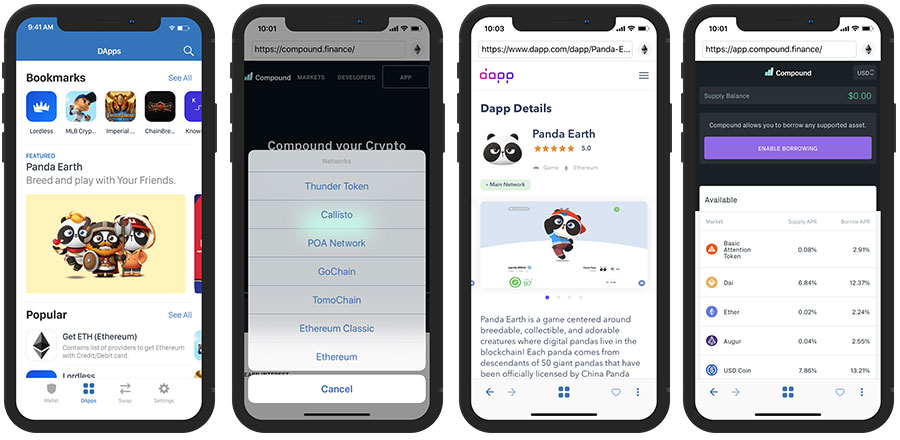
There are also gaming platforms that promise crypto-based rewards and others such as KnownOrigin, which let you collect rare digital art. Trust Wallet gives its users easy access to all of these through its app and will doubtless be at the forefront of driving adoption in this sphere.
Trust Wallet test out and vet any new DApps themselves before integrating them onto the platform. It also supports a DApp marketplace, where developers can put their efforts out for others to test and evaluate.
Trust Wallet DEX
Trust Wallet’s native built-in DEX provides users with two options to buy and sell their assets- Swap Option and Exchange Option.
The Swap Option is a simplified method of buying and selling tokens fully integrated with the Trust Wallet. For example, you can do Ethereum (ETH), and Binance Smart Chain (BNB) swaps via the 1Inch Protocol integration, as well as Binance Chain (BNB) swaps which go through Binance DEX.
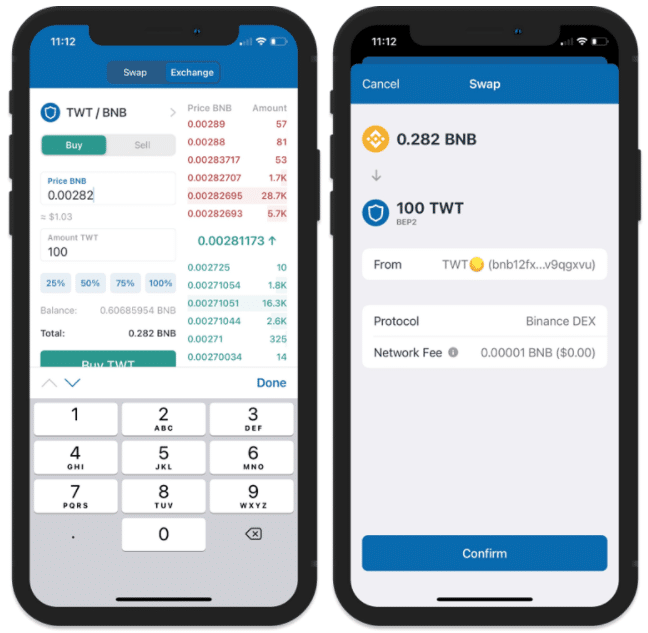
The Exchange Option looks and feels like a traditional crypto exchange where you can see an order book and set your Buy and Sell orders. However, the Exchange Option is only available for BNB to BEP2 tokens trading. Trust Wallet connects directly to Binance DEX to make the trade happen.
Trust Wallet Token (TWT)
Trust Wallet has its own governance token called TWT. The TWT token was created initially to educate and bring more people into crypto. It had no ICO/IDO and was distributed for free to everyone who referred the app to their friends and brought in more users. The token is currently trading at $0.70.
The token launched with an initial supply of 90 billion, which was later brought down to 1 billion by burning the excess tokens. The token allocation is 40% to user acquisition, 15% to developers, 15% to TWT community, and 30% to reserve stores. The token has no dedicated team allocation.
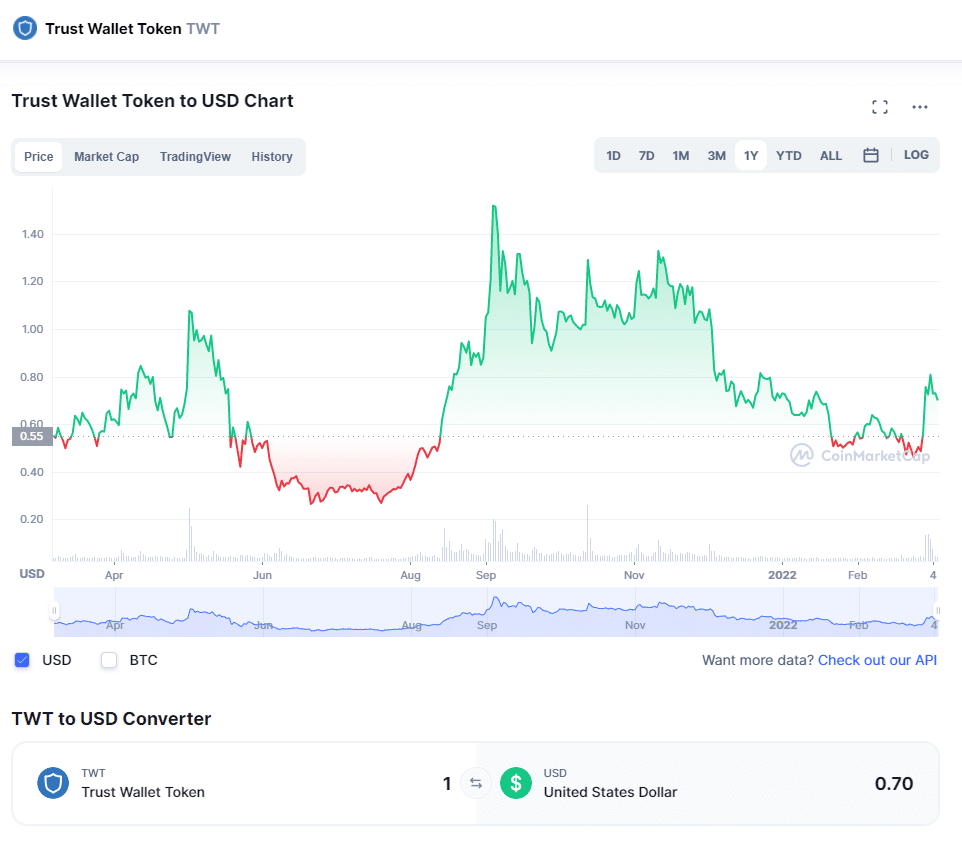
The token seems to be doing well as a governance token. The app’s first governance vote allowed users to choose whether they should integrate Filecoin support into the wallet or not. 96.73% of participants voted ‘Yes,’ which resulted in Trust Wallet rolling out FIL token support roughly three weeks later.
Trust Wallet Supported Assets
Trust Wallet is among the top wallets in the industry with impressive asset support. Trust Wallet supports millions of assets on over 100 blockchains, making this a great choice for altcoin enthusiasts. Trust Wallet offers support for major assets such as Bitcoin, Ethereum, Solana and Cardano, as well as supports lesser-known smallcap coins.
Trust Wallet NFTs
Another key feature of Trust Wallet is its NFT storage and gallery feature. Users can now view their favourite Ethereum and BSC NFTs within the app. The NFT Storage feature of the app currently supports the display of the following token standards- ERC721, ERC1155 on Ethereum, BEP721, and BEP1155 as NFTs on BSC.
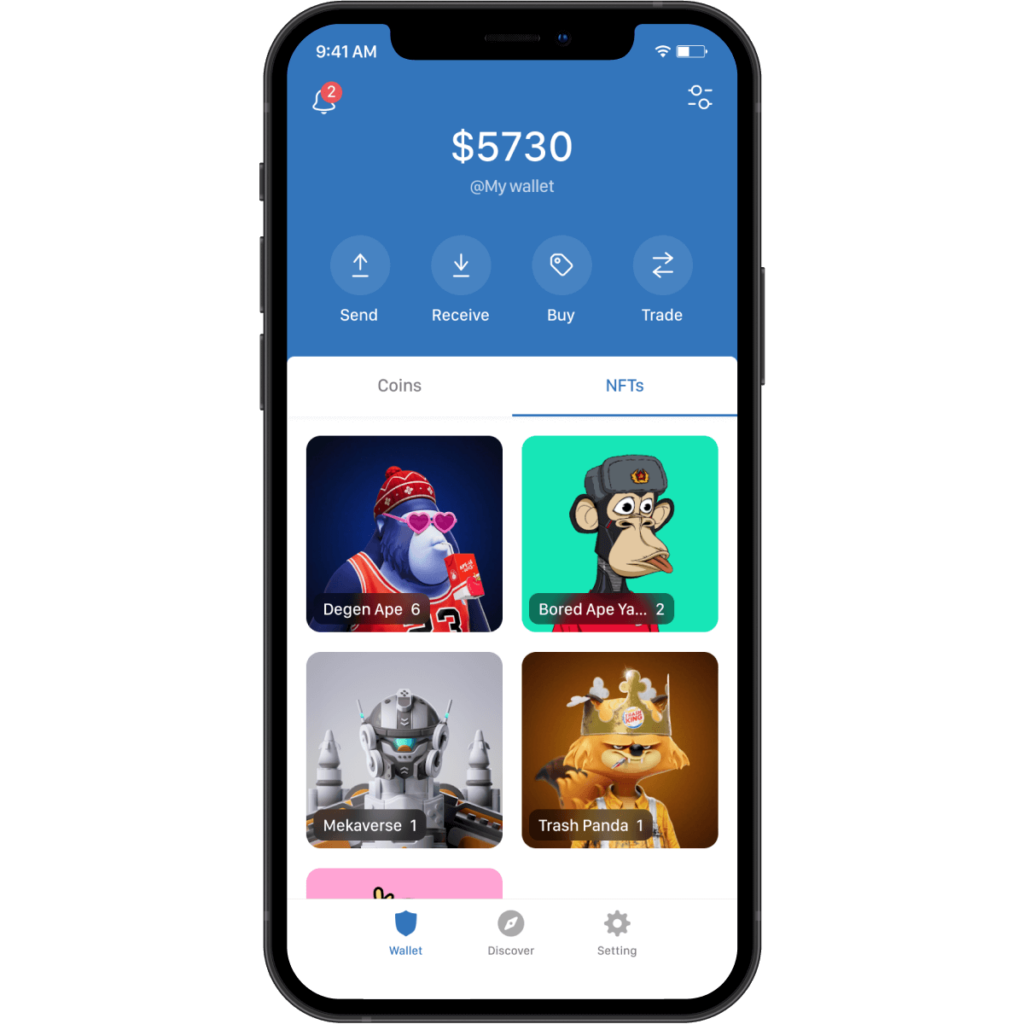
Trust Wallet allows you to easily access decentralized applications (DApps) using the in-app DApp browser (if you have an Android phone) or WalletConnect if you are using an iPhone. By enabling easy access to a wide range of NFT-powered DApps, Trust Wallet users can stake non-fungible tokens to earn yield. Trust Wallet users can do this directly with the app by connecting to NFT farming DApps with just a few clicks.
Apart from staking NFTs for yield farming on DApps like SuperFarm, users can also use the wallet to instantly connect to NFT marketplaces where they can mint and sell NFTs, all of which can be viewed directly on the app.
Trust Wallet’s Customer Support
If you’re having problems, then there is the obligatory Help Centre option, accessible via the “Settings” section of the app. Here you’ll find FAQs and troubleshooting guides, which are fairly exhaustive.
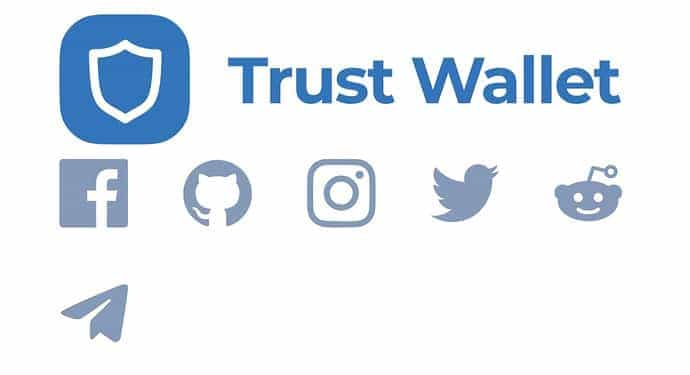
If you’re still struggling, then you can open a support ticket to get in touch with them directly. Having taken a tour through various forums, it does appear that responses to the tickets can be on the slow side.
Trust Wallet Review: The Verdict
It’s hard not to like Trust Wallet, and its faults are few. It’s easy to download and get started with, and that user interface really does make using it as straightforward as these things need to be. Then there’s that vast range of supported assets: if you can’t store your coins, then you’ve managed to get your hands on some pretty niche crypto.
Staking is becoming increasingly important to many crypto holders, as awareness of it and its benefits become more widely known. Trust Wallet has done a neat job of anticipating this demand and its staking function gives it a useful edge over other wallets that don’t yet give their users the option.
The ability to access DApps through the app is another far-sighted move that will have long-term benefits as the field expands and DeFi’s upward trend continues. For some, the DApp ecosystem can feel a little limited (how many cute collectibles do we really need, after all), but you can be sure that developers are coming up with plenty of new ideas.
And speaking of developers, they will be reassured by Trust Wallet’s open-source software that allows them to check out the codebase for themselves. Openness and transparency are two key components of blockchain and DeFi, and it’s great to see a big name buying into this philosophy.
It’s hard to quibble with Trust Wallet’s fee structure (or lack thereof). For those seeking privacy, the lack of KYC and the non-custodial nature of the wallet will tick the right boxes. However, if we’re going to split hairs, it would be good to see two-factor authentication added for additional security.
And last but by no means least, there is that partnership with Binance. To have the biggest exchange and one of the most recognisable brands in the crypto space adopt Trust Wallet as its official partner is a vote of confidence that speaks volumes.
If CZ and co are happy to put their faith in Trust Wallet, then the rest of us should feel comfortable doing so too. It will be fascinating to see what other features Trust Wallet rolls out over the coming years. With Binance behind them, you can imagine that the development team is well funded and motivated. The future looks bright.
Frequently Asked Questions
Trust Wallet is owned by Binance, one of the largest crypto exchanges in the world. The code is entirely open-source, so those developers, security experts, or anyone else who might be interested in poking about under the hood are free to do so if they wish. The platform is audited by security firm Stateful, whose report can be read here.
Trust Wallet is one of the most secure software wallets in the market right now, but (as with anything connected on the internet) there is always a possibility that it could get hacked. This could happen because of social engineering hacks or through security vulnerabilities in the software.
You can minimise the risk of getting hacked by following a few basic safety habits. If you think your Trust Wallet has been compromised, the best thing to do is immediately create and transfer your funds to a new wallet. You should also scan all devices you use to access your wallet and ensure that they are clear of any malicious software.
Trust Wallet focuses on user privacy and security. It doesn’t ask for any KYC when setting up a new account and, as a non-custodial wallet, does not store any user data. It also allows users to store their private keys locally on their devices rather than on Trust Wallet’s own servers.
While there is no two-factor authentication feature on the app yet, users can secure the app by enabling a fingerprint or pattern lock through the settings menu. However, as with all wallets, if you lose your private keys or recovery phrase, you will be unable to recover or gain access to your wallet. So, keep that in mind.
Technically speaking, Trust Wallet is completely free to use and has zero fees. The only costs incurred are gas fees for processing transactions: these are paid either to miners or to those proof-of-stake chains that charge them.
As of now, Trust Wallet is only available for mobile devices running on Android or iOS. There is no official desktop version of the wallet.
Binance owns Trust Wallet. The acquisition was completed in July 2018, with the aim of providing better service and enhancing safety for its users. The founder of Trust Wallet is Viktor Radchenko, who established the wallet in November 2017
Disclaimer: These are the writer’s opinions and should not be considered investment advice. Readers should do their own research.


